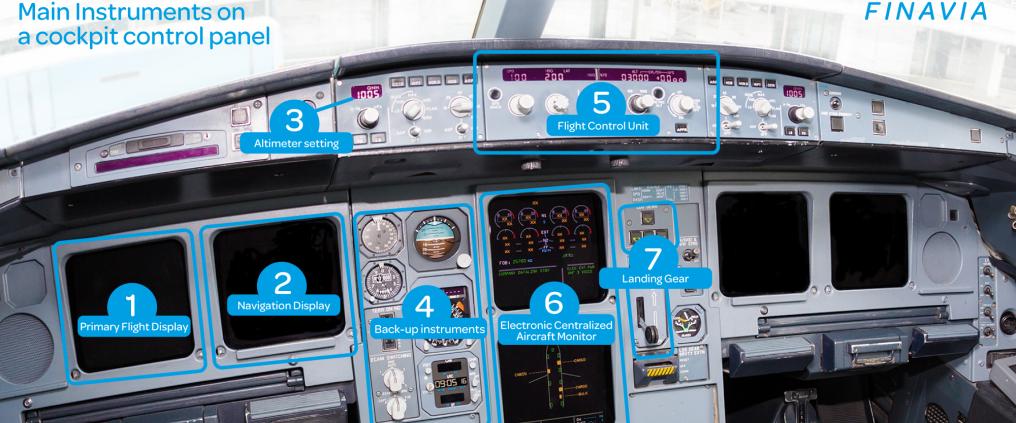In a commercial airliner’s cockpit there are hundreds and hundreds of dials, knobs, switches and monitor screens. To be able to fly, pilots need to study big, fat manuals describing what they all do.
Different aircraft models have different operating systems and therefore slightly different controls. To be able to fly a new model, a pilot needs thorough familiarization or even specialized training.
Note: here we concentrate on the cockpit control panel. The gear that a plane is actually manually flown with, including pedals, yoke and throttle, are located below the dashboard.
This infographic is based on a popular aircraft type – the Airbus 320. These are the basic instruments you see on its main panel:
1) Primary Flight Display
The primary flight display includes all information critical to flight, including attitude (a plane’s orientation relative to the horizon), airspeed, altitude, vertical speed and yaw. It lets the pilot know how the plane is positioned and how it’s moving across the sky.
This monitor combines the information that in classic airplane models used to be read from six different analog instruments into a single display. This improves the pilot's situational awareness.
2) Navigation Display
The navigation display is placed right next to the Primary Flight Display and it shows the plane’s current route and information about the next waypoint, as well as current wind speed and wind direction plus other information needed for navigation.
There are two sets of primary flight displays and navigation displays – both the captain and the co-pilot have their own.
3) Altimeter setting
This little indicator tells the pilots the value of atmospheric pressure, used to adjust the plane’s pressure altimeter so that it correctly indicates the height of the aircraft. It’s important to keep the setting calibrated with the help of air traffic control. Incorrect altimeter settings could cause the plane to accidentally fly at the wrong height, which – in the very worst case scenario – could result in mid-air collisions.
4) Back-up instruments
In case the fancy digital instruments should fail, these battery-powered standby systems and a magnetic compass would still let the pilot and first officer see the essential flight information such as speed, altitude, attitude and heading.
5) Flight Control Unit
A Flight Control unit or mode control panel is used to control heading (the direction the aircraft's nose is pointing), speed, altitude, vertical speed, vertical navigation and lateral navigation. It also has the switch that engages and disengages the autopilot and the autothrottle – options used for the majority of time on today’s commercial flights.
6) Electronic Centralized Aircraft Monitor
The Electronic Centralized Aircraft Monitor or ECAM will allow the pilot to monitor information about the engines and other plane systems such as: values for the rotational speed of the engines, fuel temperature, fuel flow, the electrical system, cockpit or cabin temperature and pressure, control surfaces and so on.
7) Landing Gear
This lever is used to extend of retract the plane’s landing gear i.e. the wheels needed for take-off and landing. There’s also an indicator that lets the pilots know which position the landing gear is in.
+ Flight Management System
“The computer” of the plane, not on display in the infographic as it is located further down, is used by the pilot or to enter and check for flight plan, speed control, navigation control, and so on.



